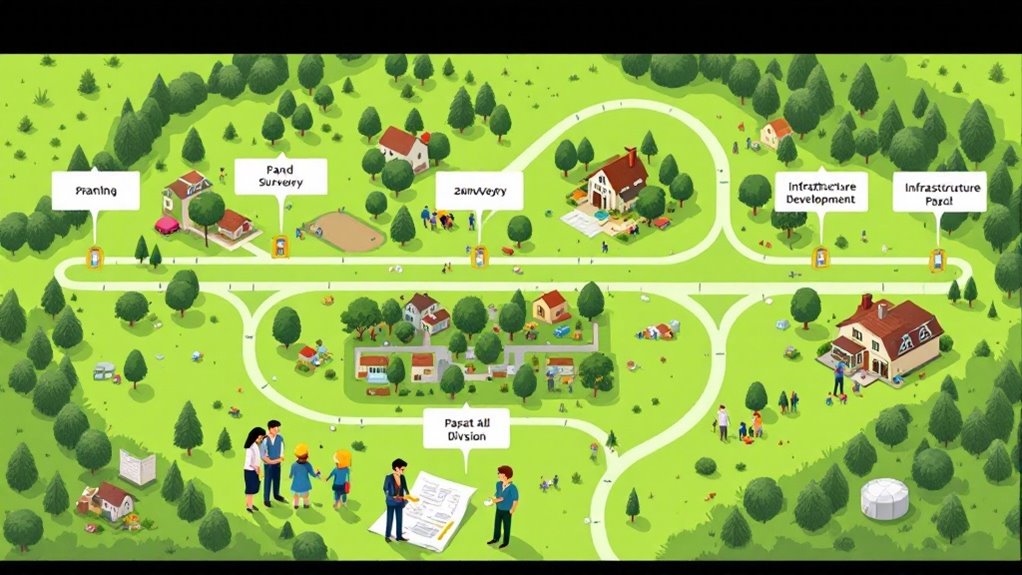When subdividing land for your family, start by understanding local zoning laws and ordinances affecting your property. Securing a land survey guarantees accurate boundaries, essential for compliance and avoiding disputes. Explore family partition exemptions that could simplify the subdivision by bypassing extensive platting processes. Analyze spatial configurations to optimize each parcel for your family’s needs and future housing. Stay informed about public notification requirements to maintain transparency. Approval from local authorities, such as the Commissioner’s Court, is mandatory. Steering through these regulatory elements carefully is key, and unraveling further details will deepen your understanding of this intricate process.
Key Takeaways
- Verify eligibility for family partition exemptions to simplify the land gifting process without formal platting.
- Compliance with zoning laws and local ordinances is crucial for successful land subdivision.
- Conduct a land survey to accurately delineate boundaries and prevent legal disputes.
- Seek approval from local authorities, including public notification, to ensure transparency and compliance.
- Subdividing land can enhance property marketability and provide future housing opportunities for family members.
Understanding Land Subdivision
When subdividing land, understanding the intricacies of the process is vital, especially if you’re considering doing it for family purposes. The real estate landscape is governed by a complex web of zoning laws and regulatory frameworks. You must first verify compliance with local ordinances, which might dictate minimum lot sizes or specific land use requirements. This involves a meticulous examination of municipal codes and a thorough spatial analysis to understand how your property aligns with these regulations.
Family partition exemptions can simplify this process, allowing you to gift sections of your land to relatives without undergoing formal platting. However, this is contingent upon county-specific provisions, so you’ll need to ascertain if such exemptions apply to your situation. Despite the potential exemption, conducting precise land surveys is vital. These surveys will delineate boundaries accurately and can prevent future legal disputes related to improperly subdivided parcels, which could otherwise hinder obtaining building permits.
Engaging with real estate professionals or land specialists can greatly streamline the subdivision process. These experts offer insights into market trends and regulatory compliance, guaranteeing your efforts align with both legal standards and ideal land use strategies. Their guidance is essential to maximize property value by transforming larger plots into smaller, marketable parcels, thereby enhancing the real estate appeal.
Reasons to Subdivide for Family
Although the decision to subdivide land for family can be intricate, it offers strategic advantages that align with both immediate and long-term family goals. Spatially, subdividing creates distinct parcels that enable multiple family members to reside in close proximity while maintaining individual ownership rights. This spatial configuration allows each member to enjoy autonomy without sacrificing familial cohesion, guaranteeing that property use aligns with personal and collective interests.
From a regulatory perspective, family partitions may benefit from exemptions in certain jurisdictions, bypassing complex platting requirements. This regulatory latitude simplifies the process of transferring land among family members, reducing administrative burdens and facilitating smoother changes. It’s important to analyze local ordinances to fully understand these exemptions and leverage them effectively in your planning.
Economically, subdividing land can enhance property value. Smaller, well-defined lots are often more marketable than expansive tracts, thereby increasing the property’s overall appeal and potential return on investment. By optimizing the spatial layout of your land, you can capitalize on this marketability, potentially selling or developing portions to fund family projects or address financial needs.
Moreover, creating multiple lots guarantees future generations have housing opportunities within a familiar community. This not only fosters continuity in familial ties but also supports long-term community planning by promoting residential stability. It’s a strategic move that reinforces the family’s legacy within the community’s spatial fabric. Additionally, understanding local market dynamics can further enhance decision-making when considering subdivision, ensuring that the investment aligns with current and future economic conditions.
Legal Requirements and Compliance
 When subdividing land for family, you must navigate zoning and land use regulations, as each county enforces distinct rules impacting your project. You’ll need to follow the approval and notification process, including obtaining the Commissioner’s Court’s nod and publicly announcing your intentions. Additionally, guarantee that your surveys and legal descriptions are precise, as these are essential for both replatted and unplatted parcels to meet compliance standards.
When subdividing land for family, you must navigate zoning and land use regulations, as each county enforces distinct rules impacting your project. You’ll need to follow the approval and notification process, including obtaining the Commissioner’s Court’s nod and publicly announcing your intentions. Additionally, guarantee that your surveys and legal descriptions are precise, as these are essential for both replatted and unplatted parcels to meet compliance standards.
Zoning and Land Use
Maneuvering the zoning and land use requirements is essential when subdividing land for family purposes. Zoning laws dictate the minimum lot size and allowable uses for newly created parcels, making it significant to analyze local ordinances before proceeding. You’ll need to guarantee that your intended subdivision aligns with these regulations, which are designed to maintain the character and utility of the area.
Engage with municipal planning authorities early in the process. Their approval is mandatory, confirming that your plans adhere to zoning standards. Some counties offer family partition exemptions, which can simplify the process by permitting land transfers to family members without formal platting. However, these exemptions vary widely, so understanding your specific county’s regulations is critical.
Consider potential easements or restrictions, as these can impose limitations on how the land can be developed or used. Evaluate spatial constraints within the context of existing utilities, access roads, and any environmental considerations. Additionally, public notification often requires advertisements to inform the community about your subdivision plans, contributing to transparent land use changes. Accurate spatial analysis guarantees compliance and assists in maneuvering the complex regulatory landscape associated with family land subdivision.
Approval and Notification Process
Understanding zoning and land use requirements lays the groundwork for the approval and notification process in subdividing land for family purposes. In Texas, the process mandates public notification, typically through advertisements, to inform the community about your subdivision intentions. This step is vital for transparency and community engagement.
Approval from the local commissioner’s court is essential to finalize your subdivision plans. This guarantees your compliance with local regulations and prevents future legal disputes. If your land is unplatted and each tract exceeds 10.01 acres, you can use metes and bounds for subdivision without a formal plat, streamlining the process. However, compliance with local zoning laws remains critical, and obtaining accurate surveys and legal descriptions helps in defining the new parcels.
In certain counties, family partition exemptions allow you to gift land to family members without requiring a formal plat, further simplifying the process. Nonetheless, adhering to these exemptions and accurately understanding the regulatory framework prevents complications. A spatial analysis of the land, considering its topography and existing infrastructure, aids in planning effective subdivisions. Remember, non-compliance can lead to significant legal issues, so guarantee thorough adherence to all legal requirements.
Survey and Replatting Requirements
Before subdividing land in Texas, comprehending the survey and replatting requirements is fundamental to guarantee legal compliance. If your land is previously platted, you must navigate the replatting process. This requires securing municipal planning approval and adhering to local zoning laws. Zoning regulations dictate land use, making certain your subdivision aligns with residential, agricultural, or commercial designations. Spatial analysis is critical, as it involves evaluating the land’s topography, existing utilities, and access roads to ascertain the proposed subdivision is feasible.
For unplatted land, you can utilize metes and bounds descriptions, provided each tract exceeds 10.01 acres. This method simplifies the process for larger parcels, bypassing the need for formal replatting. However, be aware of family partition exemptions, which may allow you to convey land to family members without formal platting in certain counties. This exemption can streamline the process, but it’s essential to confirm eligibility with local authorities.
Public notification of your subdivision intentions is mandatory. You’ll need to place ads to inform the community, creating transparency and avoiding potential disputes. Finally, the Commissioner’s Court must approve the subdivision, ensuring all legal and local regulatory requirements are satisfied before finalization.
Economic and Personal Benefits
When you subdivide land, you create new spatial configurations that can foster familial proximity and cohesion, offering housing solutions that accommodate relatives. The smaller parcel sizes often enhance market appeal, consequently boosting the overall property valuation through spatial optimization. Additionally, this process can yield economic returns by enabling you to monetize sections of your land, providing capital for reinvestment or other financial objectives. Incorporating sustainability features in the development of these new parcels can further increase their attractiveness to buyers and renters, aligning with current trends in real estate.
Family Housing Opportunities
Subdividing land for family housing offers tangible economic and personal benefits, transforming large parcels into distinct living spaces that promote both individual property ownership and familial cohesion. By creating separate lots, families establish a micro-community, each member enjoying their own space while maintaining proximity. This subdivision process, when coupled with family partition exemptions in select counties, allows you to gift land without formal platting. This regulatory advantage simplifies the creation of housing opportunities, streamlining the legal intricacies often associated with land division.
From an economic perspective, subdividing land enhances your financial prospects by allowing you to invest in smaller, more manageable parcels. This approach not only distributes property ownership but also potentially increases the land’s marketability. Subdivided lots can attract investors interested in future sales or developments, contributing to local economic vibrancy. Additionally, the economic impact extends to community benefits—such as increased property taxes—which support infrastructure development, enhancing the overall quality of life.
Spatially, subdividing land allows for strategic urban planning, balancing density with open spaces. It aligns with zoning regulations that support sustainable growth, ensuring that each subdivision adheres to local land-use policies, ultimately optimizing space for family housing opportunities.
Increased Property Value
Transforming large parcels into distinct living spaces not only fosters family cohesion but considerably boosts property value. By subdividing land, you can leverage spatial optimization to create highly marketable lots. Smaller parcels are particularly appealing in high-demand areas where residential or commercial development is thriving. This strategic segmentation increases the property’s appeal to potential buyers, including developers and investors who recognize the potential for new projects.
| Subdivision Type | Financial Return Potential |
|---|---|
| Two-lot | Moderate |
| Three-lot | High |
| Multi-lot | Very High |
A three-lot subdivision typically has a more substantial financial return compared to a two-lot division. This is because it offers increased opportunities for revenue generation through multiple sales, enhancing the overall property value. Additionally, by allocating lots to family members, you not only strengthen community ties but also elevate the land’s economic worth.
The subdivision process involves initial expenses, such as surveys and platting. However, these costs are often offset by the long-term benefits of enhanced marketability and diversified lot sizes, culminating in a profitable return on investment. Through spatial analysis, subdivision emerges as a lucrative strategy, aligning economic benefits with personal goals.
Subdivision Process Steps

Initiating the subdivision of land involves a series of mandatory steps that guarantee compliance with local regulations and transparency within the community. Start by determining if your land is platted or unplatted. For unplatted land, you can use metes and bounds to subdivide, provided each tract exceeds 10.01 acres. This method defines plot boundaries through detailed spatial analysis, vital for accurate legal descriptions and future land use planning.
Next, engage in public notification by advertising your subdivision intentions. This step guarantees community awareness and transparency, often required by local regulations. It’s a significant component for maintaining public trust and preventing disputes.
The process continues with the submission of a plat to the local municipal planning authorities. Approval from these entities, including the Commissioner’s Court, is non-negotiable. Your plat should precisely illustrate the subdivision layout, complete with boundary lines, easements, and access points. This documentation serves as the official blueprint for your land’s division and requires meticulous attention to detail.
If your subdivision is for family members, some counties offer exemptions that allow you to gift land without going through formal platting procedures. This can expedite the process, but you must verify eligibility and comply with specific local guidelines.
Understand that the subdivision process might extend over 1-2 years or longer. Planning for the financial and temporal aspects, including surveys and platting costs, is essential. With thorough preparation and adherence to procedural requirements, you’ll navigate the complexities of land subdivision efficiently and legally.
Consulting Professionals for Guidance
When starting on the subdivision of land for family, consulting professionals is indispensable to guarantee compliance with a labyrinth of local zoning laws and regulations. A land specialist can offer valuable insights into legal requirements and processes, essential for maneuvering through the complexities of subdividing land. This is especially true in states like Texas, where each county enforces unique subdivision regulations that may impact your project.
Engaging with land specialists guarantees that you understand the intricacies of replatting existing parcels or employing metes and bounds for unplatted land. Their expertise can guide you through the process, making certain that each step aligns with local zoning ordinances and avoids costly errors. Additionally, they can assist you in evaluating potential easements or restrictions on newly created parcels, preventing future legal complications.
Incorporating general contractors into your team is equally important. They provide project planning and execution expertise, ensuring construction adheres to all building codes. Their involvement can streamline the subdivision development, helping you manage schedules and budgets effectively.
Financial considerations are another significant aspect where professional guidance proves essential. Evaluating costs associated with platting and surveys with the assistance of professionals can help you assess financial feasibility before proceeding. They can identify hidden expenses and suggest cost-effective solutions.
Conclusion
In subdividing land for your family, you’ll uncover layers of spatial dynamics and regulatory intricacies. Each step—from understanding zoning laws to consulting real estate experts—reveals how personal aspirations align with legal frameworks. By managing this process, you’re not just enhancing property value, but also fostering familial bonds through shared spaces. Embrace the complexity; it transforms land into a legacy. Subdivision isn’t merely technical—it’s a strategic investment in both land and kinship.




